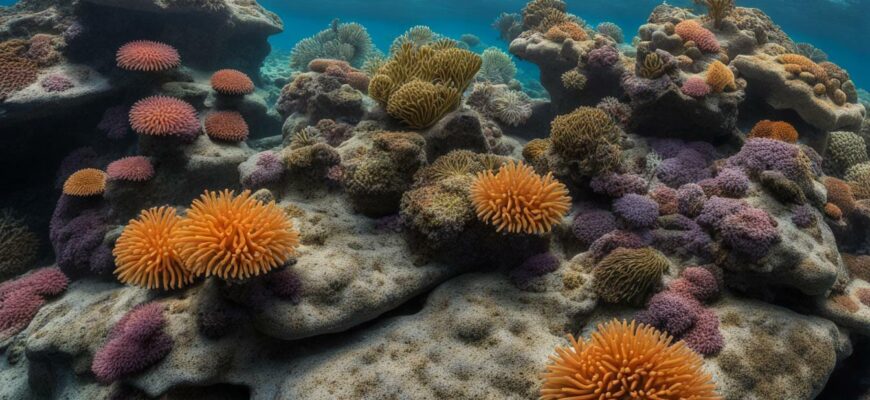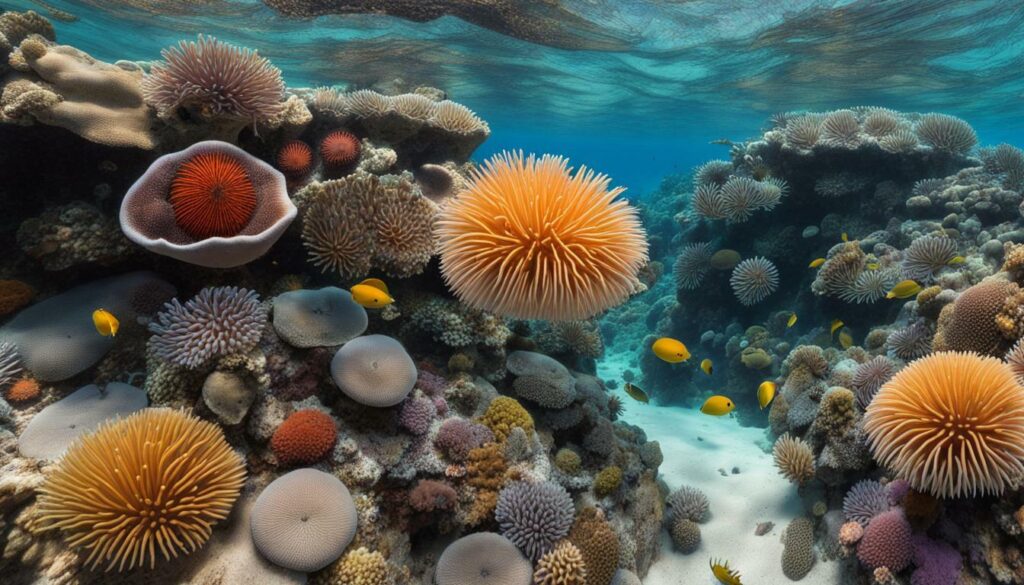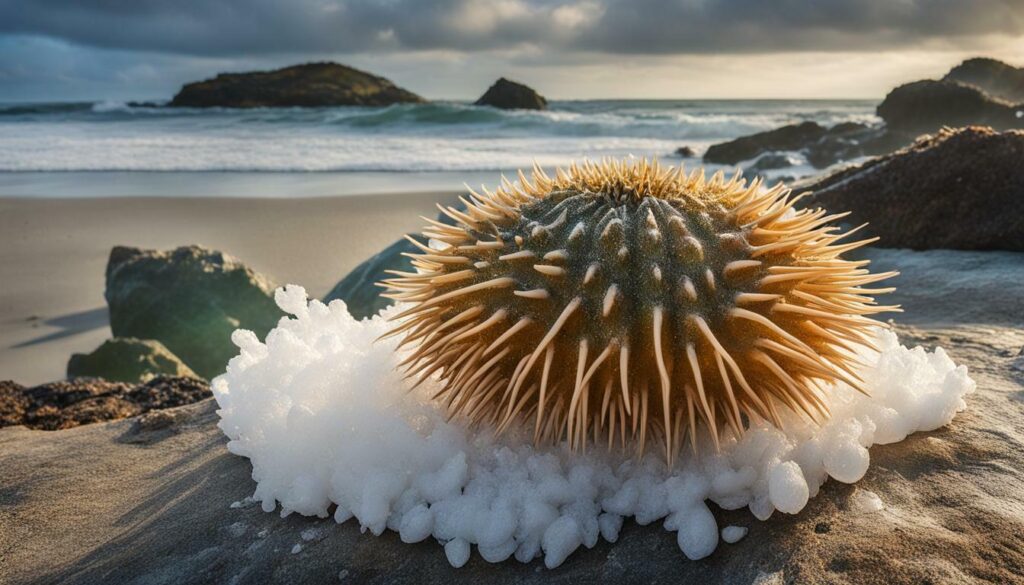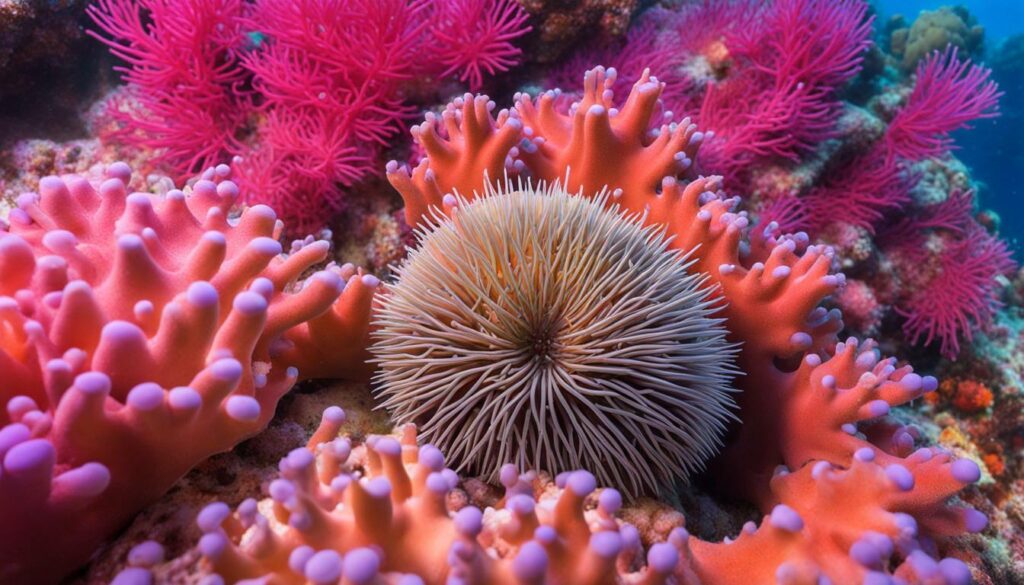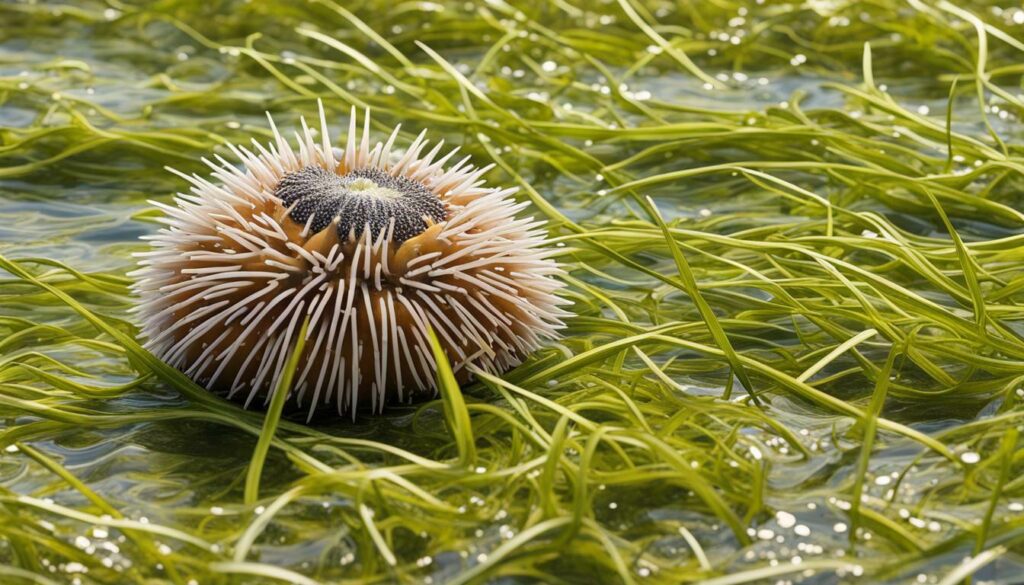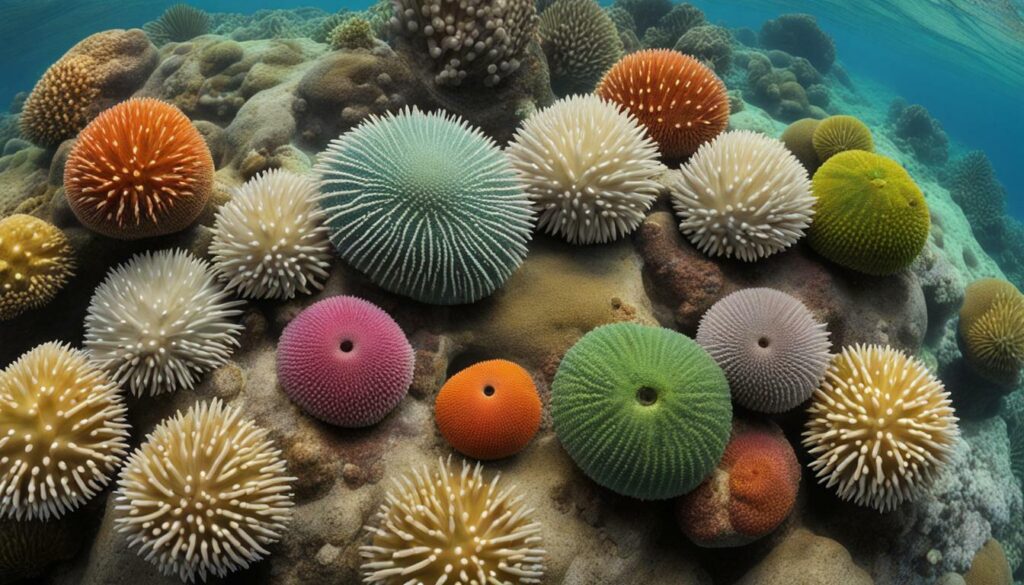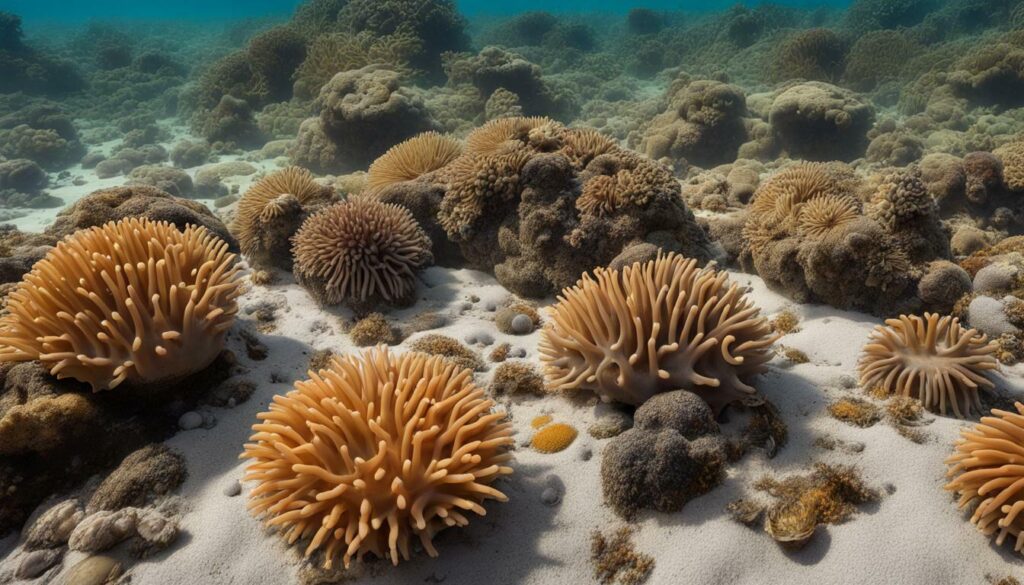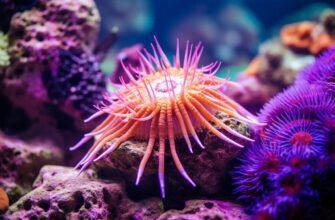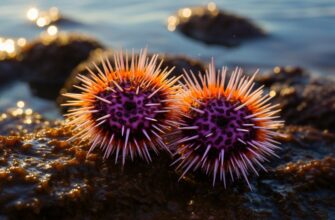Sea urchins are fascinating creatures that inhabit a variety of environments around the world. From rocky shorelines to deep oceanic environments, sea urchins have adapted to thrive in diverse natural habitats. Understanding their dwelling places is essential to protect these vital ecosystems and appreciate the role of these animals in marine biodiversity.
- Key Takeaways
- Sea Urchin Habitats around the World
- Rocky Shoreline Habitats
- Coral Reef Habitats
- Seagrass Meadow Habitats
- Deep Oceanic Environments
- Factors Influencing Sea Urchin Distribution
- Human Impacts on Sea Urchin Habitats
- Conclusion
- FAQ
- Q: Where do sea urchins live?
- Q: What are sea urchin habitats like?
- Q: How do sea urchins adapt to different habitats?
- Q: What factors influence sea urchin distribution?
- Q: How are sea urchin habitats affected by human activities?
Key Takeaways
- Sea urchins live in various natural environments around the world.
- These environments range from rocky shorelines to deep oceanic environments.
- Understanding sea urchin habitats is important for conserving marine biodiversity.
Sea Urchin Habitats around the World
Sea urchins can be found in a wide variety of habitats around the world. From rocky shorelines to coral reefs, seagrass meadows to deep oceanic environments, sea urchins have adapted to thrive in diverse ecological niches.
Rocky shorelines are one of the most common habitats for sea urchins. These prickly creatures cling to rocks with their tube feet and graze on algae and other marine vegetation. They play an important role in shaping the ecosystem of rocky shorelines by consuming excess vegetation and creating space for other marine species.
Coral reefs are another popular habitat for sea urchins. They feed on algae and other microorganisms that grow on the surface of corals, helping to maintain the health and balance of reef ecosystems. Sea urchins are also important prey for many fish and other marine animals that inhabit coral reefs.
Seagrass meadows are another favorite habitat for sea urchins. They graze on seagrass, which helps to maintain the structure and productivity of these important coastal habitats. However, excessive grazing by sea urchins can also have negative impacts on seagrass meadows, highlighting the delicate balance of these ecosystems.
Sea urchins can also be found in deep oceanic environments, where they have adapted to survive in extreme conditions. They are able to withstand high pressure and low temperatures, and they feed on organic matter that falls to the ocean floor.
The geographical distribution of sea urchins is influenced by a variety of factors, including temperature, salinity, and food availability. These factors contribute to the variation in sea urchin habitats around the world.
Despite their adaptability, sea urchin habitats are under threat from human activities such as habitat destruction, pollution, and overfishing. The loss of sea urchin dwelling places can have detrimental effects on marine ecosystems, highlighting the need for conservation measures to protect these creatures and their habitats.
Rocky Shoreline Habitats
Sea urchins are known for their ability to thrive in a variety of habitats, including rocky shorelines. These habitats are ideal for sea urchins due to their abundance of algae and other marine vegetation. Sea urchins are herbivores and use their specialized mouthparts to scrape algae off rocks and other surfaces.
Rocky shorelines are a preferred habitat for many species of sea urchins due to the protection they offer from predators. Sea urchins are slow-moving creatures and often rely on their spines for defense. On rocky shorelines, they can hide in crevices and under rocks to avoid predators such as crabs and lobsters.
These habitats provide a crucial ecological niche for sea urchins, which play a vital role in maintaining the balance of marine ecosystems. By grazing on algae and other marine vegetation, sea urchins help to control the growth of these organisms and prevent overgrowth that can harm other species.
“Rocky shorelines are a preferred habitat for many species of sea urchins due to the protection they offer from predators.”
However, rocky shoreline habitats are not immune from human impacts. Urbanization, pollution, and overfishing can all negatively impact these habitats and the sea urchins that call them home. It is important to take measures to protect and conserve these vital ecosystems for the benefit of sea urchins and all marine life.
Coral Reef Habitats
Coral reefs are one of the most diverse and vibrant ecosystems on the planet, and sea urchins play an important role in maintaining their health and balance.
Sea urchins can be found in various habitats within coral reefs, including the reef flat, reef crest, and reef slope. They are often found in crevices and under ledges, where they feed on algae and other organic matter.
The relationship between sea urchins and corals is symbiotic – sea urchins help keep the algae in check, which can otherwise overgrow and compete with corals for space and sunlight. By doing so, sea urchins help maintain the health and diversity of the coral reef ecosystem.
However, overfishing and pollution can have a negative impact on sea urchin habitats within coral reefs. When sea urchin populations are reduced, algae can quickly overgrow, degrading the coral reef ecosystem.
To protect coral reef habitats and the sea urchins that call them home, it is important to practice sustainable fishing practices and reduce pollution. By doing so, we can help preserve this vital ecosystem for generations to come.
Seagrass Meadow Habitats
Seagrass meadows are another crucial habitat for sea urchins. These coastal environments are characterized by a lush growth of seagrass, which provides food and shelter for a wide range of marine creatures, including sea urchins.
Sea urchins are often found grazing on seagrass blades, using their sharp teeth to scrape off the algae and other organic material that grows on them. In doing so, they help to maintain the health of seagrass meadows by preventing overgrowth and ensuring the productivity of these important habitats.
| Sea Urchin Species Found in Seagrass Meadows | Preferred Food Sources |
|---|---|
| Green Sea Urchin | Seagrass, algae |
| Collector Urchin | Seagrass, detritus |
| Long-Spined Urchin | Seagrass, algae |
While sea urchins are important members of seagrass meadow communities, they also face threats from human activities. Pollution, coastal development, and overfishing can all damage seagrass meadows and disrupt the delicate balance of these ecosystems.
Sea urchin grazing on seagrass in a meadow
Deep Oceanic Environments
Sea urchins are not limited to shallow coastal waters, as they can also be found in the depths of the ocean. These deep sea environments are characterized by extreme conditions, including high pressure, low temperatures, and limited food sources. Despite these challenges, sea urchins have adapted to thrive in these habitats.
One example of a deep sea sea urchin is the purple sea urchin (Strongylocentrotus purpuratus), which can be found along the Pacific coast of North America. This species can survive at depths of up to 1000 meters and has several adaptations that allow it to thrive in these conditions.
For example, purple sea urchins have a slow metabolism and can survive for months without food. They also have a specialized appendage called Aristotle’s lantern, which they use to scrape algae from rocks and other surfaces. Additionally, their spines are longer and thinner than those of their shallow water counterparts, possibly to help them navigate and stabilize in the moving currents of the deep ocean.
Despite their adaptations, sea urchins in deep oceanic environments face threats such as pollution and climate change. These factors can disrupt the delicate balance of these ecosystems and impact the distribution and survival of sea urchins and other deep-sea creatures.
“The deep sea remains one of the most poorly understood areas of our planet, and there is still much to discover about the incredible adaptations and ecological relationships of sea urchins and other deep-sea creatures.”
Factors Influencing Sea Urchin Distribution
Sea urchins have a diverse geographical distribution, inhabiting a range of natural environments around the world. The distribution of sea urchins is influenced by various factors, including temperature, salinity, and food availability.
Temperature is a crucial factor in determining the distribution of sea urchins. They are ectothermic animals that require optimal temperatures for survival and reproduction. Therefore, sea urchins occur in habitats that provide the appropriate temperature range for their species.
Salinity is another important factor that affects the distribution of sea urchins. They require specific salinities to maintain their internal water balance and survive in their natural environments. As a result, sea urchins are found in habitats with salinities that match their physiological requirements.
Food availability is also a factor that influences sea urchin distribution. They are herbivorous animals that feed on algae, seagrasses, and other marine vegetation. Therefore, they are abundant in habitats where these food sources are abundant.
The combination of these factors leads to different sea urchin habitats around the world. Some species are found in rocky shorelines, while others prefer coral reefs, seagrass meadows, or deep oceanic environments. The distribution of sea urchins may also change over time due to natural factors such as climate change or human activities such as pollution and overfishing.
Understanding the factors that influence sea urchin distribution is crucial for the conservation and management of these animals and their habitats.
Human Impacts on Sea Urchin Habitats
Human activities have had a significant impact on the habitats of sea urchins. Habitat destruction, pollution, and overfishing are among the major threats to these ecosystems. As a result, sea urchin dwelling places are becoming increasingly scarce, and their ecological niches are under threat.
One of the primary drivers of habitat destruction is coastal development. The construction of ports, marinas, and other infrastructure often involves dredging and filling in coastal areas, which can destroy seagrass meadows and rocky shorelines that are critical habitats for sea urchins.
Pollution is another major threat to sea urchin habitats. Chemicals from industrial and agricultural runoff can contaminate coastal waters and harm the marine vegetation that provides food and shelter for sea urchins. Plastic waste is also a significant problem, as sea urchins can become entangled in plastic debris, and ingesting microplastics can harm their health and survival.
Overfishing is yet another threat to sea urchin habitats. Many species of sea urchins are commercially valuable, and overfishing can lead to declines in their populations and disrupt ecological balance. In some areas, such as the Mediterranean Sea, overfishing has led to the collapse of sea urchin populations and the loss of their ecological roles in maintaining healthy marine ecosystems.
It is crucial to take steps to protect sea urchin habitats and minimize the impact of human activities on these delicate ecosystems. Measures such as coastal zone management, pollution control, and sustainable fishing practices can help preserve sea urchin habitats and support the health of marine ecosystems. By working together to protect these vital habitats, we can ensure the long-term survival of these amazing creatures and the ecosystems they call home.
Conclusion
Sea urchins are fascinating creatures that inhabit a variety of habitats around the world. From rocky shorelines to deep oceanic environments, sea urchins play important roles in maintaining the health and balance of marine ecosystems.
However, human activities such as habitat destruction, pollution, and overfishing have had a detrimental impact on sea urchin dwelling places and ecological niches. It is crucial that we take steps to protect these habitats and the important roles played by sea urchins in marine ecosystems.
By understanding the diversity of sea urchin habitats and the factors that influence their distribution, we can work towards conservation measures to preserve these amazing creatures and the environments they call home. Let us appreciate sea urchins for the incredible creatures they are and work together to protect their habitats for generations to come.
FAQ
Q: Where do sea urchins live?
A: Sea urchins can be found in various habitats around the world, including rocky shorelines, coral reefs, seagrass meadows, and deep oceanic environments.
Q: What are sea urchin habitats like?
A: Sea urchin habitats can vary depending on the location. Rocky shorelines provide a stable surface for sea urchins to cling to, while coral reefs offer a symbiotic relationship with corals. Seagrass meadows provide a source of food for sea urchins, and deep oceanic environments present unique challenges and adaptations for survival.
Q: How do sea urchins adapt to different habitats?
A: Sea urchins have evolved unique adaptations to survive and thrive in their respective habitats. Their ability to cling to rocks, graze on algae and seagrass, and withstand extreme conditions in the deep ocean all contribute to their success in different environments.
Q: What factors influence sea urchin distribution?
A: Factors like temperature, salinity, and food availability play a role in determining where sea urchins are found. These factors contribute to the geographic distribution and variation in sea urchin habitats around the world.
Q: How are sea urchin habitats affected by human activities?
A: Human activities such as habitat destruction, pollution, and overfishing can have negative impacts on sea urchin habitats. It is important to implement conservation measures to protect these vital ecosystems and ensure the survival of sea urchins and the marine ecosystems they inhabit.

